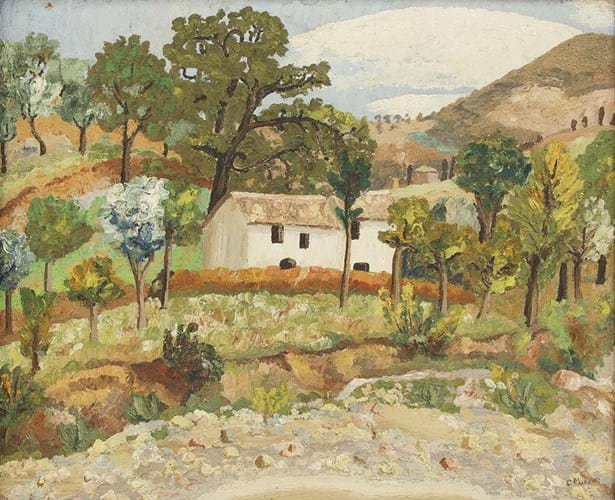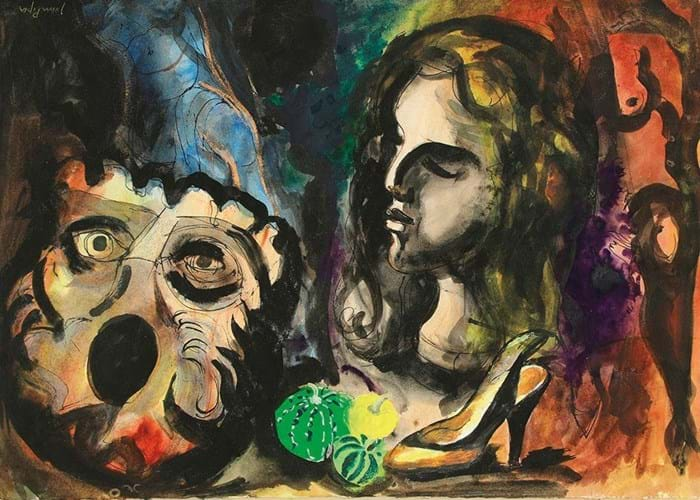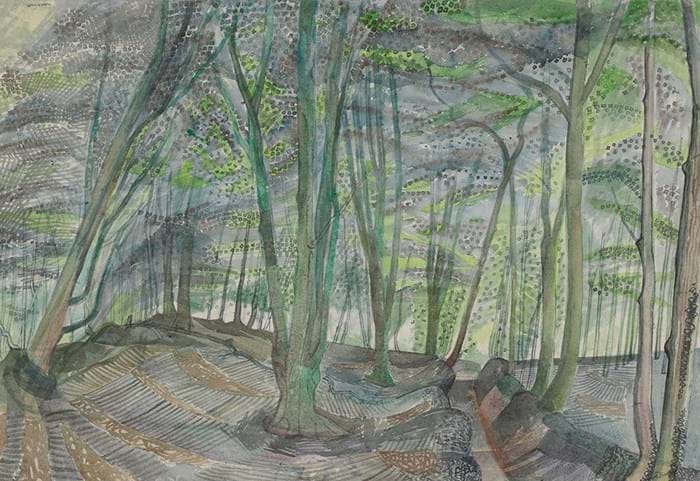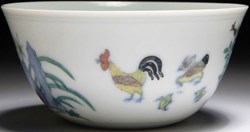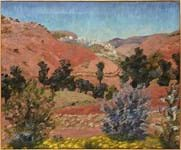Certainly this has been the case with the Mod Brit sector over the last half-century. A core group of leading painters and printmakers whose stars rose some time ago now firmly stand at the head of the field.
Works by some of these names appeared at Sworders’ (25% buyer’s premium) latest sale of Modern British and 20th century art on October 20.
While a number of the works represented less familiar parts of the respective artist’s oeuvre, they attracted significant interest nevertheless thanks to the artists’ standing.
When you consider Eric Ravilious (1903-42), for example, most people might think of his fluid Modernist watercolours or his work as a war artist. But on offer on at the Stansted Mountfitchet saleroom was an instance of a more unusual subject in an earlier medium at which he excelled: wood engraving.
Ravilious has become an important name in the Mod Brit sector, although the supply of his sought-after original landscapes and figurative works has mostly dried up over recent years – partly on account of the fact that since the artist died young his overall output was considerably less than his contemporaries.
His prints still crop up at auction fairly often. However, his earlier woodcuts are less common than the lithographs that he increasingly moved towards over the course of the 1930s.
Ravilious began producing wood engravings in the early 1920s while studying under Paul Nash at the Royal College of Art.
He had won a scholarship in 1922 and three years later received his first commission to produce a series of woodcut vignettes and illustrations for Martin Armstrong’s Desert, published by Jonathan Cape. On the back of this, he was recommended to join the newly founded Society of Wood Engravers.
The print at Sworders was a small wood engraving of a crowing rooster in a landscape. It was produced in 1930 for a prospectus published by the Golden Cockerel Press.
Chanticleer was one of two prints on the subject that Ravilious produced for the project. In the end it was the other version, Chanticleer I, depicting a rooster within a border of foliage, which was ultimately used for the 1931 Golden Cockerel Press Spring List.
That version was reproduced by John Randle at the Whittington Press in 1988, examples of which have emerged at auction before and sold for under £200.
However, Chanticleer is a rarer image. It remains unclear how many copies were printed in the 1930s but, although examples can be found in the Fry Art Gallery in Saffron Walden, Bolton Museum and the Museum of New Zealand, it is evidently extremely scarce and hard to trace any previous copies selling at auction.
This example at Sworders was therefore a chance to test the market for this print. It came to auction from the deceased estate of Virginia Chapman, whose collection at Debden Manor in Essex was dispersed by Sworders in a two-day sale in 2013. The 4¾ x 6in (12 x 15.5cm) wood engraving was signed in pencil and suffered only from some minor spotting.
With no real precedent to go on, the auction house set the estimate at just £150-250. It sold for considerably more and duly raised the bar for Ravilious in this medium.
The combination of sought-after artist, appealing image, rarity and good condition ensured it brought a strenuous competition, especially against the lowly pitch, and sold at £6400 to a buyer local to Sworders. The price surpassed the £4500 fetched by Church under a hill from 1926 that sold at Christie’s in January and held the previous auction record for a Ravilious wood engraving (source: Artprice by Artmarket).
The result was also the fourth highest for any print by the artist. The top price was the £8500 made by a copy of the colour lithograph Newhaven Harbour from 1937 that sold at Bonhams in December 2017.
Cedric Morris landscape
A landscape by Cedric Morris (1889-1982) was also on offer at Sworders.
While the high prices set by the artist-plantsman’s flower pictures over the last few years have helped him rise into the upper echelons of the Mod Brit market (including some significant examples sold at Sworders), landscapes were a smaller but significant part of his oeuvre, especially in his earlier period before he developed his passion for horticulture. However, they tend to be worth well under half the value of his floral subjects.
The example at Sworders was an 18 x 21¾in (46 x 55cm) signed oil on canvas that came to auction from a private source. It had previously sold at Sotheby’s in September 1984 for £800.
The subject was a view of hills, trees and a farmhouse and was one of the works that he likely produced on his regular summer trips France from the 1920s onwards.
The catalogue stated that it was typical of Morris’ painting style with rich impasto but also clearly defined brushstrokes applied in varying angles across the surface.
Whether or not collectors who favour his horticultural works were interested in this picture, the prices fetched by the former have clearly lifted the bar for the artist’s other works.
Estimated at £15,000-20,000, it sold online at £18,000. It was the fourth-highest price at auction for a landscape by Morris and over four times the 1984 price (accounting for inflation).
Three days later the price was eclipsed by another Morris landscape – see report on page 22.
Piper's gargoyle
Another big name in the Mod Brit sector whose work appears more regularly at auction, John Piper (1903-92), was represented at Sworders by a work on paper from the early 1980s.
Still Life with a Gargoyle was a 22in x 2ft 7in (56 x 79cm) signed pen, ink, watercolour and gouache that dated from a period when the artist experimented with new compositions. Pitched at £3000- 5000, it sold to a private buyer for £6200, a solid mid-range price for a work on paper by the artist
Another watercolour bringing interest was Beechwood, Broomfield, Somerset by Edward Bawden (1903- 89). The picture had a notable provenance: it came from the estate of dealers Patricia and Robin Pickard, who opened The Church Street Gallery in Saffron Walden in 1983. Bawden had become a friend of the couple (he designed a logo for the gallery) and their first exhibition was dedicated to the Great Bardfield artist himself.
The Pickards had bought the 21¼in x 2ft 5in (54 x 74cm) signed watercolour from The Fine Art Society in December 1976. Here it was estimated at £3000-5000 and it sold at £6900, again to an online private buyer and also showing decent demand for a well-established name.
Overall, the hammer total for the sale was £302,430 with 77% of the 359 lots finding buyers.
Sworders picture specialist Jane Oakley noted that, despite the current lockdown, the market felt buoyant for 20th century works.
“We get the impression that people at home have more time to focus on what’s out there and, as no-one is travelling, money and bonuses put aside for holidays are going instead on home improvements and works of art,” she said.



